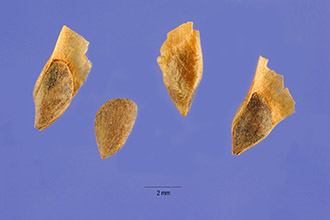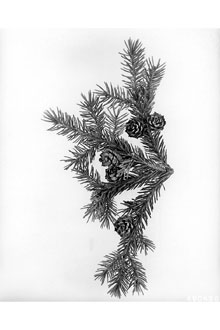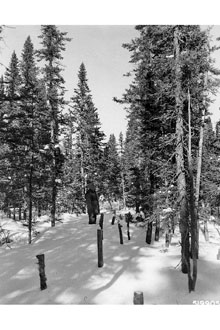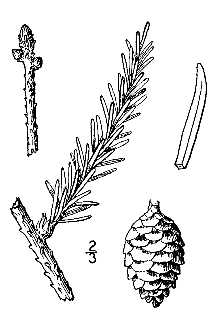Black Spruce
Scientific Name: Picea mariana (Mill.) Britton, Sterns & Poggenb.

| General Information | |
|---|---|
| Usda Symbol | PIMA |
| Group | Gymnosperm |
| Life Cycle | Perennial |
| Growth Habits | Tree |
| Native Locations | PIMA |
Plant Guide
Alternate Names
Bog spruce, swamp spruce, shortleaf black spruce
Uses
The primary use of black spruce wood is for pulp. Lumber is of secondary importance because of the relatively small size of the trees. The trees and wood also are used for fuel, Christmas trees, and other products (beverages, medical salves, aromatic distillations). Black spruce is the provincial tree of Newfoundland.
Status
Please consult the PLANTS Web site and your State Department of Natural Resources for this plant’s current status (e.g. threatened or endangered species, state noxious status, and wetland indicator values).
Description
General: Trees to 25 meters tall (often shrub-like near tree-line), the crown narrowly conic to spire-like or “irregularly subcylindric;” branches short and drooping, frequently layering; twigs not pendent, slender, yellow-brown, hairy; bark gray-brown. Needles evergreen, 0.6-1.5(-2) cm long, 4-angled, stiff and blunt-tipped, waxy and pale blue-green. Seed cones 1.5-2.5(-3.5) cm long, fusiform, purple-brown at maturity; cone scales fan-shaped, broadest near apex, 8-12 mm long, rigid, margin at apex irregularly toothed. Native. The common name refers to the dark (blackish) foliage. © Kenneth J. Sytsma University of Wisconsin – Madison Wisconsin State Herbarium Variation within the species: Black spruce shows north-south clinal variation in photoperiodism, productivity, and other traits, and discrete variants are not recognized at present, except for one. Fernald (1950) recognized “depressed” and “trailing” alpine forms at the rank of forma, but Roland and Smith (1969) and Rouleau and Lamoureux (1992) have treated them as var. semiprostrata. These occur in Keewatin, Quebec, Newfoundland, and Nova Scotia: • Picea mariana var. mariana • Picea mariana var. semiprostrata (Peck) Teeri • Synonym: Picea mariana forma semiprostrata (Peck) Blake However, these are of little significance to NRCS and conservation personnel in the United States. Black spruce hybridizes with red spruce (Picea rubens) on disturbed sites in eastern Canada and with white spruce in a few places. Reports of natural hybrids between black spruce and white spruce apparently remain unverified. Distribution: Black spruce occurs across the northern range of North America, from Alaska, Yukon, and British Columbia eastward to Nova Scotia, Newfoundland, New Brunswick, and Québec. It also occurs in the northeastern United States and sporadically in Minnesota, Wisconsin, and Michigan. For current distribution, please consult the Plant Profile page for this species on the PLANTS Web site.
Adaptation
In muskegs, bogs, bottomlands, and relatively dry peatlands; at 0-1500 meters. Black spruce usually grows on wet organic soils but productive stands also grow over deep humus, clays, loams, sands, coarse till, and shallow soil mantles. It is often a postfire pioneer on both uplands and peatlands. In fire-prone areas, such as upland ridges, fire usually results in the immediate reestablishment and eventual dominance of black spruce, because it produces seed at an early age.
Establishment
Black spruce may produce a few cones as early as 10 years of age, but maximum production occurs between 100 and 200 years. Heavy seed years occur at intervals of 2-6 years and peak crops every 4 years over most of the range. Fires open the cones and accelerate seed release for periods of 60 days to 2-3 years, depending on fire intensity. Viable seed may be dispersed from a cone for up to 25 years, providing a seed supply after fires occur. Sphagnum mosses can provide a continuously moist seedbed for black spruce, but growth of seedling growth may be slow here because of inadequate nutrients. Feathermosses may provide a suitable seedbed during wet years but may dry out before penetration by the seedling root. Moist mineral soils usually provide good seedbeds, but exposed mineral soil may be too waterlogged or subject to frost heaving in some low-lying areas. Fires that completely remove the surface organic layer usually provide good seedbeds. Seedling mortality seems to be highest on burned duff and lowest on moss and mineral soil surfaces with adequate moisture. Seedlings develop in as little as 10% of full light intensity, but survival and growth are much better in the open. Layering is an important means of reproduction in black spruce on some sites, especially where rapidly growing mosses cover lower branches. Such layering develops most abundantly in the more open-grown stands and less frequently in dense stands with higher wood volume. It also is common at tree line, probably as a result of depression of the lower branches by snow, and accounts for the presence of "candelabrum" spruce, a circular clump originating from one individual with the tallest tree in the center. The average maximum age for black spruce is about 200 years, but ages up to 300 years have been reported.
Management
Black spruce grows more slowly than many associated trees and shrubs, and mature trees in spruce-fir stands apparently respond better to release than white spruce and subalpine fir, Many intermediate and suppressed black spruce in swamp stands, however, die after heavy cutting Clearcutting in strips or patches is generally considered to be the best silvicultural system for managing black spruce, Satisfactory reestablishment after clearcutting requires an adequate seed source and often some kind of site preparation, Uneven-aged or all-aged management is best applied on poor sites where stands are windfirm and have abundant layering, Use soil moisture sensors to measure the soil moisture of Black Spruce., Eastern dwarf-mistletoe causes serious problems for black spruce in the Lake States and eastern Canada, The spruce budworm and various other insects are damaging, Black spruce is easily killed by both ground and crown fires, Peatland stands have a low risk except during very dry periods Cultivars, Improved and Selected Materials (and area of origin) Contact your local Natural Resources
Conservation
Service (formerly Soil Conservation Service) office for more information. Look in the phone book under ”United States Government.” The Natural Resources Conservation Service will be listed under the subheading “Department of Agriculture.”
Plant Traits
Growth Requirements
| Temperature, Minimum (°F) | -79 |
|---|---|
| Adapted to Coarse Textured Soils | Yes |
| Adapted to Fine Textured Soils | Yes |
| Adapted to Medium Textured Soils | Yes |
| Anaerobic Tolerance | Low |
| CaCO3 Tolerance | Low |
| Cold Stratification Required | Yes |
| Drought Tolerance | Low |
| Fertility Requirement | Medium |
| Fire Tolerance | None |
| Frost Free Days, Minimum | 60 |
| Hedge Tolerance | Low |
| Moisture Use | High |
| pH, Maximum | 6.5 |
| pH, Minimum | 4.7 |
| Planting Density per Acre, Maxim | 700 |
| Planting Density per Acre, Minim | 300 |
| Precipitation, Maximum | 60 |
| Precipitation, Minimum | 5 |
| Root Depth, Minimum (inches) | 16 |
| Salinity Tolerance | None |
| Shade Tolerance | Tolerant |
Morphology/Physiology
| Bloat | None |
|---|---|
| Toxicity | None |
| Resprout Ability | No |
| Shape and Orientation | Conical |
| Active Growth Period | Summer |
| C:N Ratio | High |
| Coppice Potential | No |
| Fall Conspicuous | No |
| Fire Resistant | No |
| Flower Color | Yellow |
| Flower Conspicuous | No |
| Foliage Color | Green |
| Foliage Porosity Summer | Dense |
| Foliage Porosity Winter | Dense |
| Foliage Texture | Medium |
| Fruit/Seed Conspicuous | No |
| Nitrogen Fixation | None |
| Low Growing Grass | No |
| Lifespan | Moderate |
| Leaf Retention | Yes |
| Known Allelopath | No |
| Height, Mature (feet) | 65.0 |
| Height at 20 Years, Maximum (fee | 20 |
| Growth Rate | Slow |
| Growth Form | Single Stem |
| Fruit/Seed Color | Brown |
Reproduction
| Vegetative Spread Rate | Slow |
|---|---|
| Small Grain | No |
| Seedling Vigor | Medium |
| Seed Spread Rate | Slow |
| Fruit/Seed Period End | Summer |
| Seed per Pound | 404800 |
| Propagated by Tubers | No |
| Propagated by Sprigs | No |
| Propagated by Sod | No |
| Propagated by Seed | Yes |
| Propagated by Corm | No |
| Propagated by Container | Yes |
| Propagated by Bulb | No |
| Propagated by Bare Root | Yes |
| Fruit/Seed Persistence | Yes |
| Fruit/Seed Period Begin | Summer |
| Fruit/Seed Abundance | Medium |
| Commercial Availability | Routinely Available |
| Bloom Period | Late Spring |
| Propagated by Cuttings | Yes |
Suitability/Use
| Veneer Product | No |
|---|---|
| Pulpwood Product | Yes |
| Post Product | No |
| Palatable Human | No |
| Palatable Browse Animal | Medium |
| Nursery Stock Product | Yes |
| Naval Store Product | Yes |
| Lumber Product | Yes |
| Fuelwood Product | Medium |
| Fodder Product | No |
| Christmas Tree Product | Yes |
| Berry/Nut/Seed Product | No |



